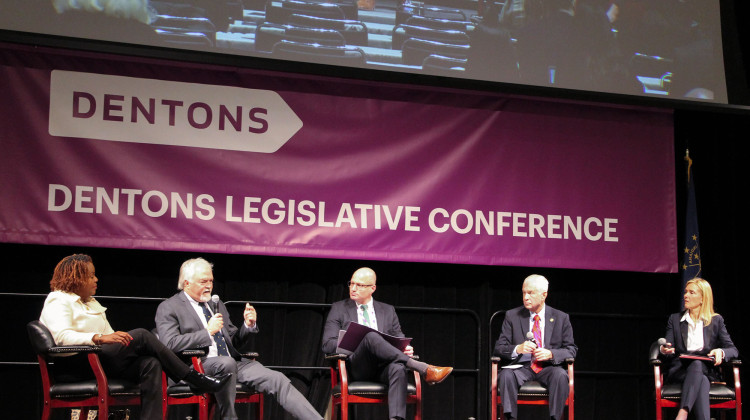
FILE - Palestinians crowd together as they wait for food distribution in Rafah, southern Gaza Strip, Nov. 8, 2023. Catastrophic hunger is so dire in two world hotspots that famine is imminent in northern Gaza and approaching in Haiti, with hundreds of thousands of people in both places struggling to avoid starvation, according to international food security experts and aid groups.
(AP Photo/Hatem Ali, File)By Nurith Aizenman
An international committee of experts issued a dire warning about Gaza this week: Famine is now "imminent" in northern Gaza and a risk across the entire territory. Yet they also found that about 30% of the population – some 667,000 people – are currently experiencing "catastrophic" levels of hunger, meaning those individuals have so little food they are effectively starving.
So why stop short of declaring the situation a famine already? And who are these experts that get to decide?
NPR spoke with two people working within the web of government officials, aid workers, and analysts responsible for monitoring hunger crises around the world.
Here are five takeaways:
There's a very specific, internationally-agreed upon system for gauging hunger crises
The process that the world currently relies on to track food emergencies got its start in the 1980s, says Tim Hoffine, quality assurance and methods adviser on the United States Famine Early Warning Systems Network, known as FEWS NET. In the wake of famines in East and West Africa, aid officials in the United States government decided they needed a way to continuously monitor hunger levels around the world. The idea, says Hoffine, was to provide "independent, timely and evidence-based analysis" to help decision makers prevent future famines.
That's what led to the establishment of FEWS NET, Hoffine's employer. It's funded through the State Department's United States Agency for International Development and contracts with experts outside the U.S. government to collect and analyze data on at-risk locations on a monthly basis.
But even after FEWS NET's creation there was no agreed-upon international standard for designating the severity of a given hunger crisis. That made it difficult to coordinate with other donor governments and aid organizations on making quick and effective decisions about where to allocate scarce aid dollars.
As World Food Programme spokesperson Steve Taravella put it, "There is a serious need for the aid community to understand the levels of hunger in a scientific, authoritative way, rather than just anecdotally from people saying this is happening here or there. We needed something reliable and authoritative that everybody working on these issues could use as a baseline for moving forward." So in 2004 during a major food emergency in Somalia, FEWS NET worked with a raft of international partners to develop and fund what's now known as the "Integrated Food Security Phase Classification" initiative – or IPC.
"It's a mouthful of humanitarian jargon, but it's basically the authoritative, respected, scientific mechanism for measuring levels of hunger in different areas," says Taravella.
The IPC has a coordinating office at the United Nations Food and Agriculture Organization in Rome. But it convenes special working groups of experts from multiple partners in order to analyze troubled locations on a case-by-case basis.
Essentially, says Hoffine, "Donors wanted a single estimate of need. And the IPC responded to that desire for consensus around a single estimate."
Multiple conditions need to be met before a location is technically considered in "famine"
The IPC categorizes a given location's hunger level according to a five-phase scale. (FEWS NET – which continues to monitor world hunger hotspots on a monthly basis independently of the IPC – uses that scale as well.)
Communities in IPC phase one are considered basically fine. In phase two people are still generally getting enough food, but the community is considered "stressed" because a substantial share of its households are having difficulty affording other essential non-food needs.
At phase three – called "crisis" – "that's where we start getting nervous," says Taravella. Many households are starting to have trouble getting food specifically, in addition to other basics. "They might not have meals as often," he notes.
People in phase three may resort to coping strategies that enable them to get enough food in the short term, but at a cost that reduces the resources they can count on to survive in the longer term. For instance, says Taravella, "they might start selling off livestock. It's a very uncomfortable period." IPC's latest finding is that 26% of people in Gaza are in this "crisis" phase.
In phase four, called "emergency," these hardships become more pronounced. The gaps in food consumption are even bigger, and people resort to even more dangerous strategies to feed themselves – Hoffine calls them "really extreme forms of coping that would help you protect food consumption, but are going to jeopardize your ability to meet your food needs later on." This could include a person liquidating practically all their assets, or in the case of farmers, eating the seeds they would need to plant in order to get food from the next harvest.
In phase four the incidence of acute malnutrition and excess deaths starts to rise. FEWS NET's report places Gaza as a whole in this phase currently. IPC puts the figure at 39% of the population in phase four – with another 30% in the last and highest phase.
It's not until a location reaches this phase five that it's actually considered in "famine." Three conditions must be met, starting with at least one in five households in the area experiencing what's called "catastrophe." This means, says Hoffine, that the household is "facing an extreme lack of food that would in the near term lead them to face acute malnutrition and mortality."
The second condition: At least 30% of children under age 5 are suffering from acute malnutrition based on measurements of their height and weight – essentially they start to look skeletal, what's known as wasting. Lastly, at least two in every 10,000 adults are dying every day from causes other than trauma.
That final measure, notes Hoffine, reflects the fact that extreme lack of food often kills people not only through outright starvation, but by compromising their immune systems to an extent that they're unable to fight off diseases.
There's an even higher bar for actually declaring a famine.
It's also not enough for either FEWS NET or the IPC to find that the three criteria for famine have been met. Before they can formally classify a location as being in phase five, they are obligated to submit their evidence to a review committee of experts specially convened for that purpose by the IPC. In the case of the latest reports on Gaza, IPC and FEWS NET had produced separate though very similar analyses, and the review committee considered and signed off on both simultaneously.
Even if a location is found to be in phase five, neither FEWS NET nor the IPC would make any official proclamation that a famine is underway. "It's up to government institutions, United Nations upper leadership, and other high-level representatives to actually make a famine declaration," says Hoffine.
Even before "famine" conditions are officially reached in an area, many people there may already be starving
The fact that all three thresholds must be met before a location is considered in famine helps explain why a large share of the region's people may experience dire conditions well before it officially reaches phase five.
"What's really important to understand is that until famine thresholds are breached, you would still have people dying from hunger or hunger-related mortality," says Hoffine. "So in Gaza you would still expect there to be mortality. And the longer this goes without a solution, the more that we can expect that sort of mortality to occur."
Indeed, the IPC's report on Gaza estimates that in northern Gaza about 70% of people are now facing "catastrophic" levels of food insecurity. The report also finds that "it's highly likely" the threshold for acute malnutrition among children has just been reached, and it concludes that unless urgent steps are taken, the death rate will rise above the famine threshold by May.
For its part, the Israeli government has played down the hunger crisis in Gaza, with one government spokeswoman going so far as to call it a "myth." Other Israeli officials blame Hamas for the chaos in Gaza that hampers aid delivery. Israel has allowed some food aid into the territory since easing a two-week blockade in October, but aid groups say Israeli measures, such as searching trucks for weapons, are limiting the number of deliveries and exacerbating the crisis.
It's not too late – but time is running short
But Hoffine and Taravella stress that the caveats in their organization's reports are the key here. Both FEWS NET and IPC say that if hostilities in Gaza are halted and humanitarian workers are given the access they need to rush in aid, there is still time to avoid widespread famine there.
This, after all, is the point of the international famine classification system. When a location is found to be in one of the higher hunger phases, it doesn't trigger any obligatory steps that governments or organizations must take. Yet the designation is still a powerful tool for mobilizing a response, says Taravella, because it puts the world on notice.
Taravella points to a recent observation by his organization's chief economist, Arif Hussain. "Several years ago," said Hussain, "when [famines] happened in certain places, you could say, 'I'm sorry. I did not know.' Today we see crises in real time. So we cannot say we did not know."
 DONATE
DONATE








 Support WFYI. We can't do it without you.
Support WFYI. We can't do it without you.